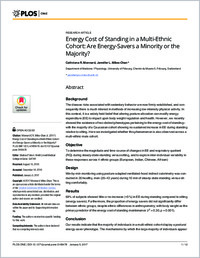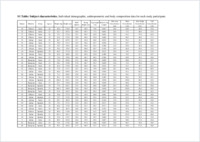Energy cost of standing in a multi-ethnic cohort: are energy-savers a minority or the majority?
- Monnard, Cathriona R. Department of Medicine / Physiology, University of Fribourg, Switzerland
- Miles-Chan, Jennifer L. Department of Medicine / Physiology, University of Fribourg, Switzerland
-
05.01.2017
Published in:
- PLOS ONE. - 2017, vol. 12, no. 1, p. e0169478
English
The disease risks associated with sedentary behavior are now firmly established, and consequently there is much interest in methods of increasing low-intensity physical activity. In this context, it is a widely held belief that altering posture allocation can modify energy expenditure (EE) to impact upon body weight regulation and health. However, we recently showed the existence of two distinct phenotypes pertaining to the energy cost of standing–with the majority of a Caucasian cohort showing no sustained increase in EE during standing relative to sitting. Here we investigated whether this phenomenon is also observed across a multi-ethnic male cohort.Objective: To determine the magnitude and time-course of changes in EE and respiratory quotient (RQ) during steady-state standing versus sitting, and to explore inter-individual variability in these responses across 4 ethnic groups (European, Indian, Chinese, African)Design: Min-by-min monitoring using posture-adapted ventilated-hood indirect calorimetry was conducted in 35 healthy, men (20–43 years) during 10 min of steady-state standing versus sitting comfortably.Results: 69% of subjects showed little or no increase (<5%) in EE during standing compared to sitting (energy savers). Furthermore, the proportion of energy savers did not significantly differ between ethnic groups, despite ethnic differences in anthropometry; with body weight as the primary predictor of the energy cost of standing maintenance (r2 = 0.30, p = 0.001).Conclusion: Our results indicate that the majority of individuals in a multi-ethnic cohort display a postural energy-saver phenotype. The mechanisms by which the large majority of individuals appear to maintain sitting and standing postures at the same energetic cost remains to be elucidated but is of considerable importance to our understanding of the spontaneous physical activity compartment of EE and its potential as a target for weight regulation.
- Faculty
- Faculté des sciences et de médecine
- Department
- Département de Médecine
- Language
-
- English
- Classification
- Biological sciences
- License
- License undefined
- Identifiers
-
- RERO DOC 280240
- DOI 10.1371/journal.pone.0169478
- Persistent URL
- https://folia.unifr.ch/unifr/documents/305289
Other files
Statistics
Document views: 72
File downloads:
- mil_ecs.pdf: 145
- mil_ecs_sm.pdf: 90

